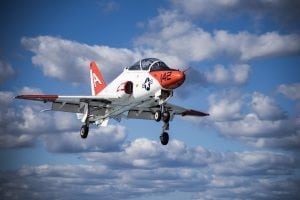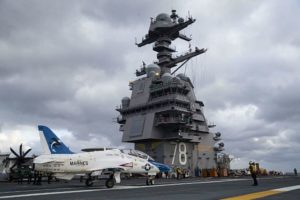Following a safety pause issued last month for the entire Navy jet trainer fleet due to an engine blade issue, the Navy announced on October 31 it resumed operations on individual aircraft it confirmed do not have the problem.
The service instituted the safety pause grounding
the T-45C Goshawk jet trainer fleet on October 14 after a T-45C experienced a low-pressure compressor blade failure before taking off on October 11. The engine was taken off the plane and sent to maintenance for diagnosis whereupon the Chief of Naval Air Training (CNATRA) decided on the pause “out of an abundance of caution” (Defense Daily, Oct. 19).

The T-45C is a tandem-seat jet trainer that helps train Navy and Marine Corps pilots.
The Navy said an engineering analysis by the service and engine maker Rolls Royce found that a subset of T-45C engine blades “do not meet the manufacturer’s engine specifications.” Those failing specifications remain grounded, but the aircraft returning to flight “are compliant with these specifications.”
Navy spokesperson Elizabeth Fahrner declined to name how many aircraft are still grounded “due to operational security concerns.”
CNATRA Rear Adm. Richard Brophy said the process for returning Goshawks to operations is based on an engineering analysis performed by Naval Air Systems Command, with safety of aviators named as the most important factor.
“The aircraft we are flying are verified and known-good. We have the highest confidence in the compliance of these aircraft,” Brophy said.
The Navy confirmed flight operations on the remaining grounded T-45C fleet will stay paused as the Navy and Rolls Royce evaluate engineering data on the non-conforming parts and work to return more aircraft to operational status.
Fahrner told Defense Daily the engineering investigation is in the final stages at Rolls Royce and additional information may become available once it finishes.
Fahrner also confirmed the Navy will clear additional T-45Cs “only after those aircraft have been thoroughly inspected and are determined to be compliant with manufacturing specifications. The Navy is assessing its usable inventory of blades, blade repair options and achievable manufacturing rate of new blades; this information will set the pace for returning aircraft to flight.”
The Navy said while the fleet is partially grounded, training air wings and squadrons will focus on maximizing ground training, including classroom lectures, simulators, and computer-based training. However, the spokesperson acknowledged this will have an impact on training pilots.

“We know this issue will present a challenge to our pilot production, but it is too early to determine the extent in which production will be impacted. Our pilot production will recover as more aircraft are cleared to resume flight operations,” Fahrner said.
Fahrner confirmed the Navy’s contract with Rolls Royce is firm-fixed price and “there is currently no indication the U.S. government is responsible for costs on this contract associated with the fix.”
Brophy reiterated the reintroduction of T-45Cs will be staggered but not rushed.
“It is essential that our maintenance partners analyze and diagnose this issue thoroughly so training operations can fully resume with the safety of each of our aviators as a top priority,” Brophy said.